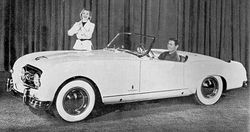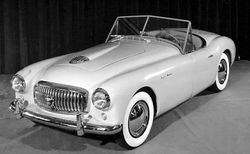.
Nash-Healey
The Nash-Healey was a two-seat sports car, built in partnership between Nash-Kelvinator Corporation and British auto enthusiast Donald Healey between 1951 and 1954. It was the first American sports car built since the Great Depression and served as a halo vehicle to promote the sales of the other Nash models.See Wikicars' comprehensive Nash-Healey Review.
Recent Changes
Styles and Major Options
Pricing
Gas Mileage
Reliability
Safety
Photos
Colors
Main Competitors
Unique Attributes
Resale Values
Criticisms
Racing
In its first year, one Nash-Healey was entered in the Mille Miglia race and it finished in ninth place, a good performance for such a new car.
Over the next years, the Le Mans 24h races had several Nash Healeys entered. In 1954, they finished first and second in their class (Sports 3000), with all the other Nash Healeys in this class also completing this grueling race. That year there was one more Nash Healey fitted with a larger 5000 cc engine to compete with the powerful Jaguars and Ferraris. However, it did not did not finish due to oil-pressure problems.
By 1954, the Nash-Healey had acquired a resume of racing trophies. Plausibly for its expense in production and lower sales because its higher price tag, the Nash corporate sports car passion was significantly changed after a series of racing accidents where a certain competitor's cars made several fireball crashes into the grandstands full of spectators (See 1955 Le Mans disaster). Nash corporate conscience took up a new advertising slogan; "The only race we're interested in is the human race." Hence, the Rambler image was conceived in thought, and Nash set about to replace the Nash-Healey with a different fun small car; the Nash Metropolitan.
Second generation (1952–1954)
Restyle
Perhaps for increased production rate, and perhaps for his associated manufacturing esteem, in 1952, Italian designer Pinin Farina was brought in to restyle Healey's original body design. Carrozzeria Pininfarina was contracted to build the bodies, which were now fabricated of steel. Nevertheless, from Italy, the bodies were shipped to Healey were the suspension systems and the power trains were installed. It was expensive to build because of all the shipping involved. The Nash engines and other mechanical components came from the U.S. to Britain. The body was brought from Italy to Britain where Healey assembled all the parts into complete cars. Finished cars were then shipped for sale in the U.S.
For the 1954 model year, a hardtop version supplanted the convertible model, which was built on a slightly longer wheelbase.
First Generation/Origins
As originally conceived, Nash Motors would supply the Ambassador's inline six-cylinder (252 in³, 4130 cc, 140 hp.) engines, three-speed manual transmissions with overdrive, as well as the differentials to Great Britain for installation into handcrafted aluminum bodied 2-seat sports cars designed and built by Healey. (Nash already had many inroads into Europe with its appliance division; Kelvinator, named after William Thomson, 1st Baron Kelvin "Lord Kelvin" of England, who pioneered modern refrigeration.)
The car had a ladder-type steel frame, with Healey's suspension components, aluminum heads, and multi-carburetor systems were fitted in passionate sports car tradition. The cars returned to the United States for sale through the Nash dealership network. Healey's design for this car was later incorporated into its Austin-Healey. The Nash-Healey debuted at the 1951 Chicago Auto Show. It had luxurious appointments including leather upholstery and an adjustable steering wheel. The new Nash model was compared to the Jaguar XK120.
Production
Slightly more than 500 Nash-Healey sports cars were built in the four-year model run. For contextual comparison, the Nash-Healey is framed in U.S. auto history with the 1953 Kaiser Darrin, 1953 Chevrolet Corvette and 1955 Ford Thunderbird.
1951 - 104 (Healey design)
1952 - 150
1953 - 162 (roadsters and hardtops)
1954 - 90 (only hardtops)
Specifications
Wheelbase: 102 inches, 2590 mm. (roadster)
Length: 170 inches, 4337 mm. (roadster)
Width: 60 inches, 1524 mm. (roadster)
Tread: 53 inches, 1346 mm. (front and rear)
Weight: 2400 pounds, 1088 kilograms
Brakes: Drum
Front suspension: trailing link with coil springs and anti-roll bar
Rear suspension: rigid axle with coil springs and track bar
Worldwide
Design quirks and oddities
Awards
See also
| NASH MOTORS | ||
|
AM General | Chrysler | Hudson | Jeep | Kelvinator | Nash Motors | Nash-Kelvinator | Rambler | Australian Motor Industries | Vehiculos Automotores Mexicanos 1916 - 1957: 600 · Airflyte · Advanced Six · Ambassador · Nash-Healey · La Fayette · Metropolitan · Rambler · Rebel · Statesman Ajax · American Motors · Hudson · Nash-Kelvinator · Rambler (AMC) | ||
| name of founder/s | Include the marque's Corporate website here and indicate as such. | indicate if marque is A brand of the (official name of parent company) or independent |



